Price is now beginning to move higher, which is what the Elliott wave counts both expected.
Summary: Upwards movement for a third wave should begin now. The first target is at 1,294 where a small consolidation may unfold. The target for this upwards swing to end is at 1,308, in the first instance, and may be as high as 1,380 (but this looks less likely now).
Reduce risk at this time to only 1-3% of equity on any one trade. Always trade with stops.
New updates to this analysis are in bold.
Last monthly charts for the main wave count are here, another monthly alternate is here, and video is here.
Grand SuperCycle analysis is here.
The wave counts will be labelled first and second. Classic technical analysis will be used to determine which wave count looks to be more likely. In terms of Elliott wave structure the second wave count has a better fit and fewer problems.
FIRST ELLIOTT WAVE COUNT
WEEKLY CHART
There are more than 23 possible corrective structures that B waves may take, and although cycle wave b still fits well at this stage as a triangle, it may still be another structure. This wave count looks at the possibility that it may be a double zigzag.
If cycle wave b is a double zigzag, then current upwards movement may be part of the second zigzag in the double, labelled primary wave Y.
The target remains the same.
Within intermediate wave (C), no second wave correction may move beyond the start of its first wave below 1,205.41. However, prior to invalidation, this wave count may be discarded if price breaks below the lower edge of the black Elliott channel. If this wave count is correct, then intermediate wave (C) should not break below the Elliott channel which contains the zigzag of primary wave Y upwards.
There are now three problems with this wave count which reduce its probability in terms of Elliott wave:
1. Cycle wave b is a double zigzag, but primary wave X within the double is deep and time consuming. While this is possible, it is much more common for X waves within double zigzags to be brief and shallow.
2. Intermediate wave (B) within the zigzag of primary wave Y is a double flat correction. These are extremely rare, even rarer than running flats. The rarity of this structure must further reduce the probability of this wave count.
3. Although intermediate wave (C) should be continuing so that primary wave Y ends substantially above the end of primary wave W, the duration and depth of minor wave 2 within it now looks to be too large at the weekly time frame.
DAILY CHART
The analysis will focus on the structure of intermediate wave (C). To see details of all the bull movement for this year see daily charts here.
Intermediate wave (C) must be a five wave structure, either an impulse or an ending diagonal. It is unfolding as the more common impulse.
It is possible that minor waves 1 and now 2 may both be over. Minor wave 2 may have ended very close to the 0.618 Fibonacci ratio. If it continues lower, then minor wave 2 may not move beyond the start of minor wave 1 below 1,205.41.
Minor wave 1 lasted 44 days and minor wave 2 may have lasted 20 days, just one short of a Fibonacci 21.
It is of some concern now that minor wave 3 appears to be starting out rather slowly and that minute wave ii within it is now a very deep correction.This is somewhat unusual for a third wave and offers some support now to the second Elliott wave count. With StockCharts data showing a steady decline in volume as price rises, this concern is validated.
A base channel is added to minor waves 1 and 2. If this wave count is correct, then lower degree second wave corrections should find support at the lower edge of the base channel. Friday’s candlestick is below the base channel, which now reduces the probability of this wave count.
Minute wave ii may now be over as a double zigzag structure.
It is again of concern that upwards movement this week does not have support from volume. The start of a third wave up at two degrees should be a strong movement.
HOURLY CHART
If minute wave ii is over as a very deep double zigzag, then it may have lasted a Fibonacci eight days.
Because minute wave ii here is so deep, the appropriate Fibonacci ratio to use to calculate a target for minute wave iii is 2.618.
Minute wave iii may only subdivide as a five wave impulse upwards. Minuette waves (i) and (ii) may now be complete.
Minuette wave (iii) may only subdivide as a five wave impulse. Within minuette wave (iii), subminuette wave i may be complete and subminuette wave ii may be incomplete. Subminuette wave ii may not move beyond the start of subminuette wave i below 1,267.97.
A base channel is added now to minuette waves (i) and (ii). Along the way up, lower degree corrections should find very strong support at the lower edge of the base channel. Gold almost always behaves like this; breaches of its base channels do happen, but they are uncommon.
The next wave up for this wave count would now be expected to be a third wave at four degrees.
SECOND ELLIOTT WAVE COUNT
WEEKLY CHART
It is still possible that cycle wave b is unfolding as a regular contracting or barrier triangle.
Within a triangle, one sub-wave should be a more complicated multiple, which may be primary wave C. This is the most common sub-wave of the triangle to subdivide into a multiple.
Intermediate wave (Y) now looks like a complete zigzag at the weekly chart level.
Primary wave D of a contracting triangle may not move beyond the end of primary wave B below 1,123.08. Contracting triangles are the most common variety.
Primary wave D of a barrier triangle should end about the same level as primary wave B at 1,123.08, so that the B-D trend line remains essentially flat. This involves some subjectivity; price may move slightly below 1,123.08 and the triangle wave count may remain valid. This is the only Elliott wave rule which is not black and white.
Finally, primary wave E of a contracting or barrier triangle may not move beyond the end of primary wave C above 1,295.65. Primary wave E would most likely fall short of the A-C trend line. But if it does not end there, then it can slightly overshoot that trend line.
Primary wave A lasted 31 weeks, primary wave B lasted 23 weeks, and primary wave C lasted 38 weeks.
The A-C trend line now has too weak a slope. At this stage, this is now a problem for this wave count, the upper A-C trend line no longer has such a typical look.
Within primary wave D, no part of the zigzag may move beyond its start above 1,357.09.
DAILY CHART
This second wave count expects the new wave down may be deeper and longer lasting than the first wave count allows for. At this stage, in the middle of this downwards wave intermediate wave (B) looks incomplete.
A common length for triangle sub-waves is from 0.8 to 0.85 the length of the prior wave. Primary wave D would reach this range from 1,170 to 1,158.
If primary wave C is correctly labelled as a double zigzag, then primary wave D must be a single zigzag.
Within the single zigzag of primary wave D, intermediate wave (A) is labelled as a complete impulse.
Intermediate wave (A) lasted twenty days, just one short of a Fibonacci twenty-one. Intermediate wave (B) may be about the same duration, so that this wave count has good proportions, or it may be longer because B waves tend to be more complicated and time consuming.
So far intermediate wave (B) has lasted eighteen sessions. The next Fibonacci number in the sequence is twenty-one which would see it continue now for another three sessions.
At its conclusion intermediate wave (B) should have an obvious three wave look to it here on the daily chart.
Minor wave B may be complete here or close to completion as a double zigzag.
Minor wave A will subdivide as either a five wave impulse or a three wave zigzag. If it is seen as a zigzag, then the whole structure for intermediate wave (B) may be a flat correction, which would allow for minor wave B to move below the start of minor wave A at 1,260.72.
HOURLY CHART
Intermediate wave (B) may be a regular flat correction. Within intermediate wave (B), minor wave B has passed the minimum requirement of 0.90 the length of minor wave A. B waves within 0.90 to 1.05 the length of A waves indicate a regular flat correction. The most common length for C waves within regular flats is equality in length with the A wave.
Minor wave C would be extremely likely to make at least a slight new high above the end of minor wave A at 1,305.72 to avoid a truncation.
Both wave counts require a five wave structure upwards to complete. For this second wave count it would be labelled minor wave C.
So far, within minor wave C, minute waves i and now ii may be complete. This second wave count also expects a third wave up to now begin, but only at two degrees. Some increase in upwards momentum should be expected, and it should have support from volume.
The current small pullback, which is here labelled minuette wave (ii), looks incomplete. This hourly chart shows a slightly different way of labelling most recent movement. A small triangle may be completing for subminuette wave b within a zigzag downwards for minuette wave (ii).
When this second wave correction is complete, then an increase in upwards momentum would be expected.
Minuette wave (ii) may not move beyond the start of minuette wave (i) below 1,267.97.
TECHNICAL ANALYSIS
WEEKLY CHART

Click chart to enlarge. Chart courtesy of StockCharts.com.
What looks like a possible double bottom here with the last swing low three weeks ago is too small to be classified as a correct double bottom. The two troughs of a double bottom should be about 10% from the peak in between. Here, they are only 3.6% from the peak.
The long lower wick on the last completed weekly candlestick is bullish, but volume tells a different story as it is bearish.
On Balance Volume may again lead the way. Support may force a bounce here.
DAILY CHART
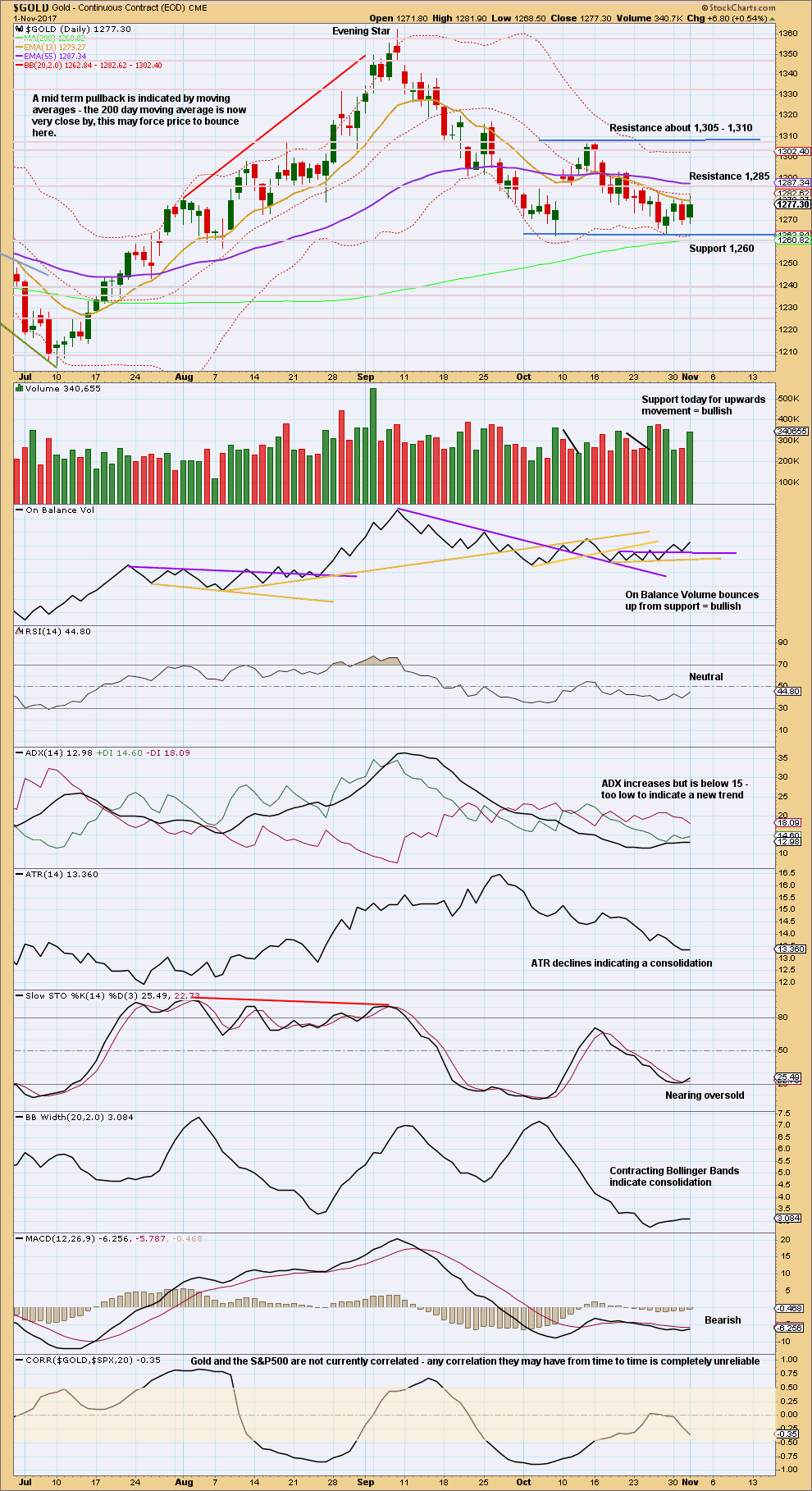
Click chart to enlarge. Chart courtesy of StockCharts.com.
Price is very clearly consolidating. Expect swings from support to resistance and back again. Use Stochastics in conjunction with support and resistance to signal when each swing ends. Be aware that trading a consolidating market is much more risky than trading a trending market, and reduce risk accordingly. Only experienced traders should consider trading the swings within a consolidation. Reduce risk to 1-3% of equity. Always trade with stops. Here, move stops to a little below support and above resistance to allow for overshoots; give the market room to move.
With Stochastics very close to oversold and price at support, an upwards swing may begin here or very soon. Look for resistance about 1,305 – 1,310. This also supports the second Elliott wave count.
Volume and On Balance Volume are today more clearly bullish giving some confidence that an upwards swing may be beginning now.
GDX DAILY CHART

Click chart to enlarge. Chart courtesy of StockCharts.com.
GDX broke below support four days ago, on a downwards day with support from volume. This looks still like a classic downwards breakout. It is common after breakouts for price to curve back and test support or resistance, and that looks like what is happening today.
The longer upper wick on today’s candlestick looks a little bearish. It looks like GDX may now begin to move down and away.
However, volume for this downwards movement is very light, so it is suspicious.
If price moves back above resistance at 22.75, then the consolidation zone may have to be widened. If this happens, then expect an upwards swing to next resistance about 23.95.
But the bottom line for GDX today is it is in a downwards trend. Assume GDX remains so while price remains below resistance at 22.75. With weakness still, traders should take profits or keep trailing stops tight.
Published @ 06:00 p.m. EST.
[Note: Analysis is public today for promotional purposes. Specific trading advice and comments will remain private for members only.]


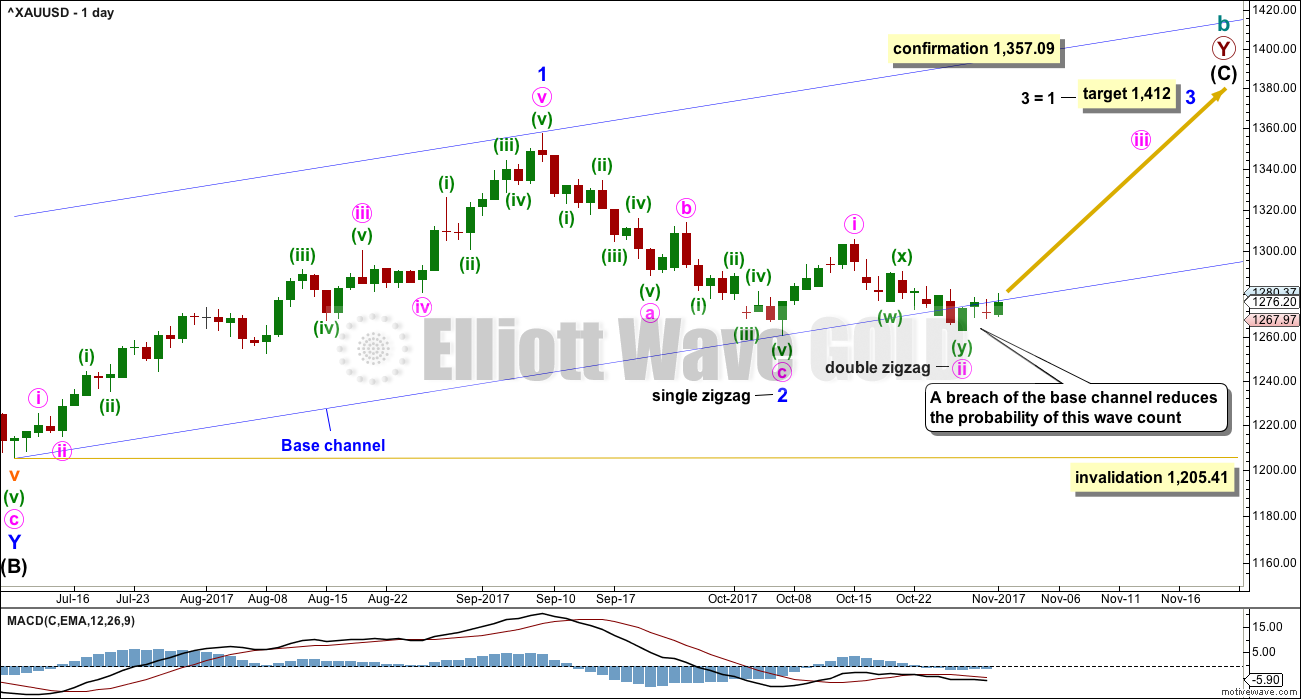
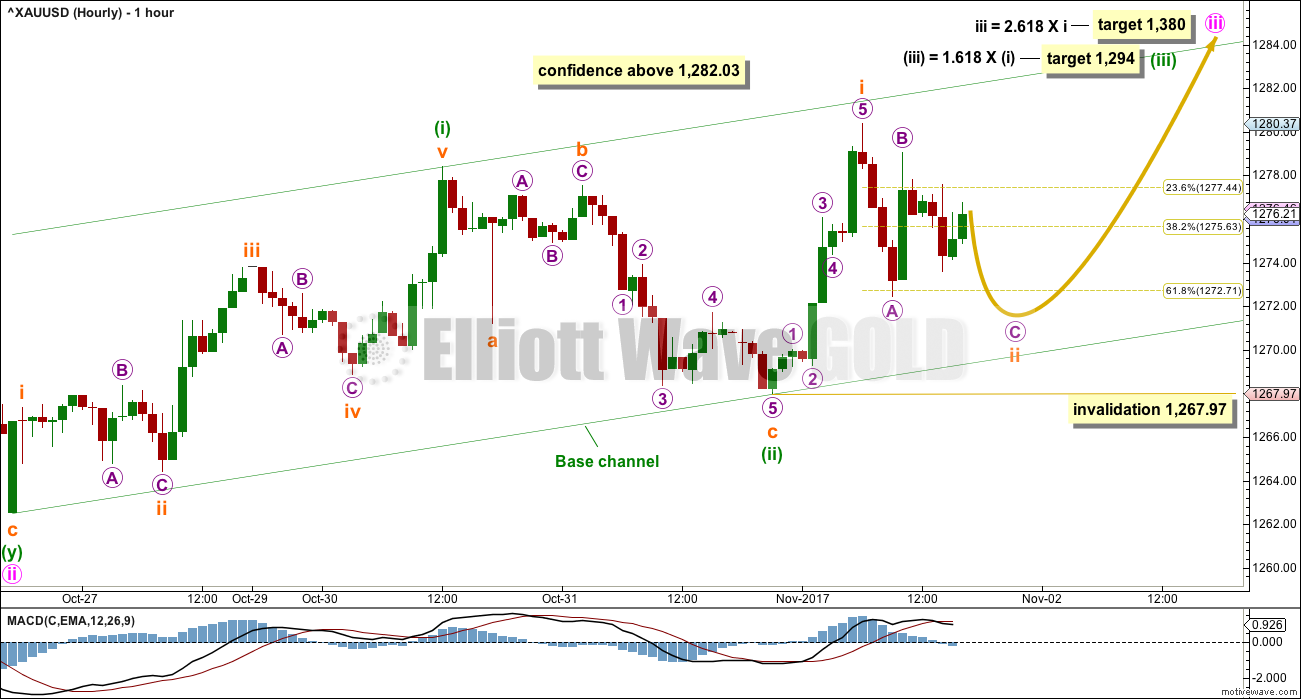
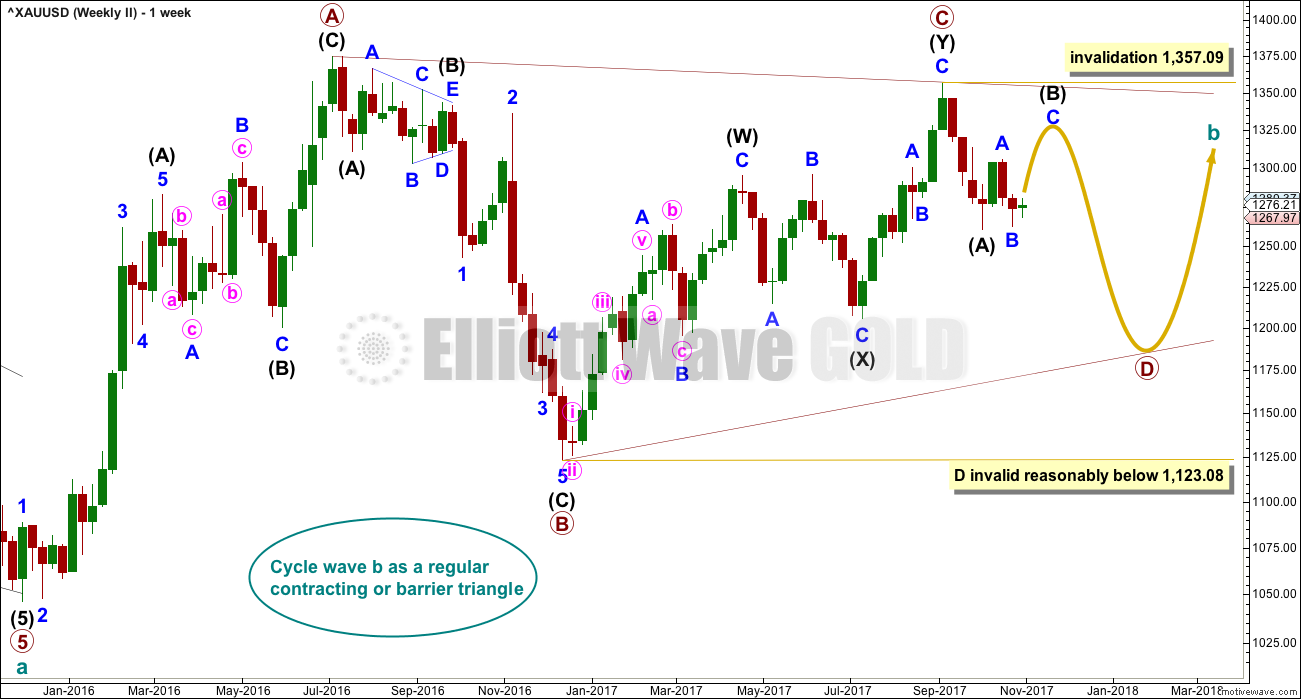
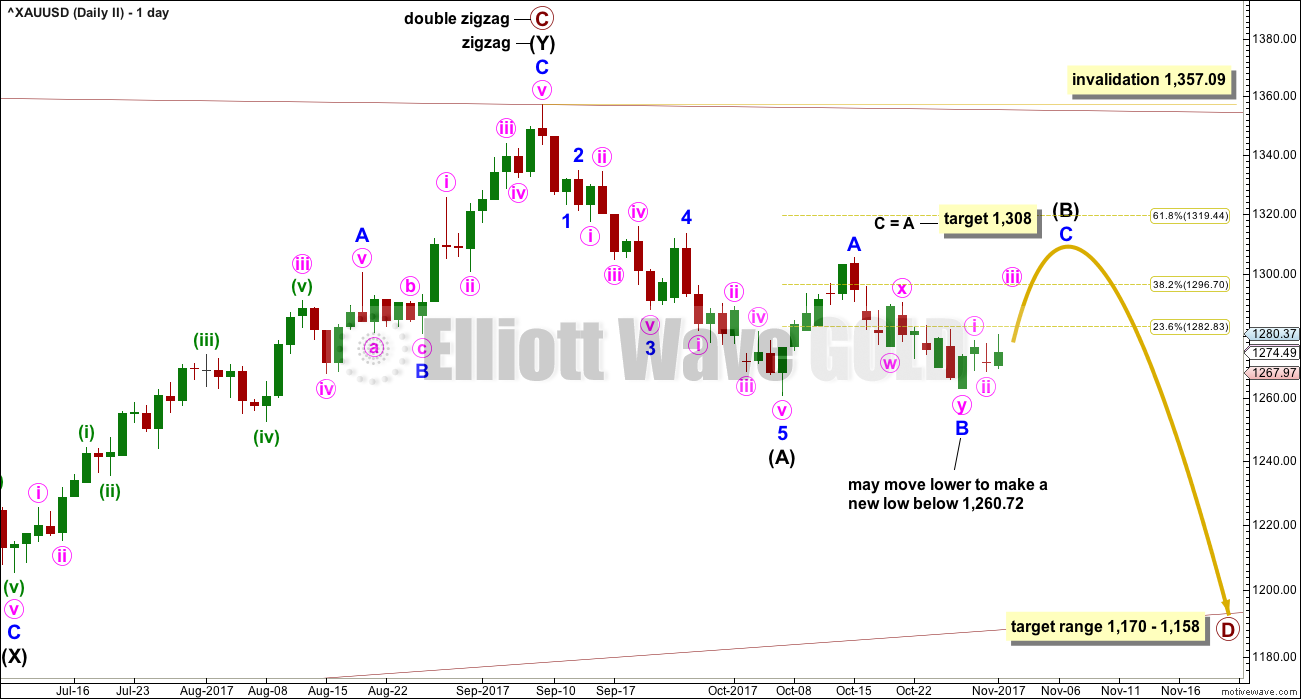

Imo Gold 1274-73 should hold for a short term upturn/rally to take out 1285-86. Risk, a break below 1269. Silver is confusing the issue though and will likely whipsaw….
Updated hourly chart:
Another first and second wave completing.
With all this overlapping it looks like a diagonal could possibly be unfolding in a first wave position. But I’ve tried to see if that fits, and it will not meet the rules regarding wave lengths for either a contracting or expanding diagonal. And so overlapping first and second waves is the only option viable at this stage, if a new impulse upwards is unfolding.
Price very neatly found support at the lower edge of the base channel. If any members noticed that, it was the perfect opportunity to go long for a short term trade there.
Oh yes, and we also now have a new high above the confidence point.
Let’s see what volume has to say today about this little upwards move…. if it supports it then I’m going to be very confident of upwards movement next week. If it doesn’t… then a pullback?
Tomorrow will be an interesting day. Non Farm payrolls. They are calling for a huge 300k number. I recall last time they were looking for a very small number, and turned out to be negative. If they blow this number out, I can’t imagine what will happen to gold. But having a hard time believing it will beat the number.
Also of note, they just announced the new fed nominee, who i believe is known to be dovish, and better for gold than the other main nominee, although a muted reaction from gold at best to the announcement. i think everyone is waiting for tomorrow before committing.
On the daily, gold is oversold and just barely holding on to the 100 day and the 10 day. Decent chance of a move up tomorrow. But it’s really a toss up i think
Thanks Lara. Not sure there was an opportunity to go long on that spike down to the base line, as it may not have existed. Not seeing it in my chart. Same with several other spikes in the data you are getting. I do see today’s spike though, which happened during the NY session
Lara, awesome share posted on the 31st of your surfing in Tonga. Really enjoyed seeing your ‘alternate’ wave action! Cheers 🙂
Most welcome 🙂